Cooking outdoors doesn’t have to mean charred hotdogs and instant noodles. If you’ve ever wondered how to cook over a fire without burning your dinner or losing your cool, this guide is for you.
With the right tools, tips, and a little patience, campfire cooking can be an experience that’s just as rewarding as the hike that led you there. Plus, we’ll throw in some lifestyle hacks that include our go-to outdoor companion: FRE nicotine pouches.
Key Takeaways:
-
Learn the basics of campfire cooking techniques
-
Know what gear to pack for successful outdoor cooking methods
-
Follow essential fire safety tips for cooking
-
Try easy and tasty campfire recipes
-
Discover how FRE fits into your chill outdoor moments
Why Cooking Over a Fire Matters
Cooking over a fire connects you to the basics. It’s how humans have cooked for thousands of years, and doing it today adds a cool factor to any outdoor plan. You’re not just tossing ingredients into a pot. You’re controlling heat, watching flames, and getting your hands dirty in the best way.
It’s also one of those things that makes camping or road tripping feel more complete. The pace slows down. You pay attention. You look at the stars more than your screen. The taste? It hits different. That smoky char adds something no stove can match. And you don’t need high-end tools. Some wood, a lighter, and a pan will do just fine.
What Tools Do You Need For Campfire Cooking?
Before anything gets cooked, you need the basics. Campfire cooking isn’t complicated, but having the right tools makes the whole thing smoother.
Here’s what you’ll want in your pack:
-
Fire starters: Matches, lighters, or a ferro rod work best.
-
Cookware: Cast iron pans, Dutch ovens, or grill grates hold up well to heat.
-
Utensils: Bring long-handled tongs, spatulas, and heat-resistant gloves.
-
Cleanup gear: Keep it clean with biodegradable soap, a sponge, and a trash bag.
-
Safety supplies: A bucket of water, fire extinguisher, and basic first-aid kit go a long way.
If you're new to cooking over fire, it helps to learn the basics, like how to start a fire without matches, before heading out into the wild.
How do you build a fire that’s good for cooking?
A cooking fire gives you steady, controllable heat. If it’s too weak, your food won’t cook right. If it’s too wild, things might burn fast. The key is knowing how to build it from the ground up.
Choose a safe spot
Before striking a match, find a solid place to build your fire. Safety comes first.
-
Use a clear, flat surface
-
Stay at least 15 feet away from dry brush, grass, or branches
-
Avoid windy areas where flames can shift quickly
-
Follow local fire rules, especially during dry seasons
Gather your fire-building materials
You’ll need three basic types of wood. Each one plays a different role in getting your fire going and keeping it hot enough for cooking.
-
Tinder: Use dry grass, pine needles, or bark shavings. These catch flame quickly and help spark the fire.
-
Kindling: Small twigs or sticks no thicker than your finger. This feeds the flame after the tinder catches.
-
Fuelwood: Larger logs, about the size of your forearm. These burn longer and help create the coal bed you’ll cook over.
Pick the right fire structure
How you stack your wood changes the way the fire burns. Different meals call for different setups.
-
Teepee fire: Stack your tinder in the middle, then lean your kindling and small sticks around it like a tent. Light the center. This one burns hot and fast. It’s great for boiling water or cooking things that don’t need long heat.
-
Log cabin fire: Lay two larger logs parallel to each other. Stack two more on top, going the opposite way. Keep building up the sides like a square. Put your tinder and kindling in the center. This one burns slower and gives off steady heat, perfect for foil packets or Dutch oven meals.
Give it time to build coals
Once your fire’s lit, don’t rush to cook. Let it burn until you get a bed of glowing coals. That’s where the steady heat comes from. Cooking directly over flames sounds fun, but coals are where you’ll get more control and better results. Move the coals around if needed to create hotter and cooler zones for different foods.
What campfire cooking techniques work best?
Fire is unpredictable, so how you cook matters just as much as what you cook.
-
Direct heat cooking: This one’s simple. Place your food right over the flame or coals. Think skewers, flatbreads, or sausages. Flip them regularly. Don’t walk away unless you like surprises.
-
Indirect heat cooking: This is better for food that takes longer. You’re placing items to the side of the fire, not over it. Great for meat cuts, foil meals, and veggies. Coals provide even heat without charring everything on the outside.
-
Using foil packets: These save cleanup time and cook pretty evenly. Toss your chopped ingredients in, wrap them up, and let the fire do its thing. Want to avoid a mess? Double wrap the foil.
-
Dutch oven cooking: Heavy but worth packing. Use it for chili, biscuits, or stews. Place it over coals and add some on top for even heat. Let it do its job while you sit back.
What safety tips should you follow while cooking?
Cooking outdoors is just one part of the bigger picture. Building solid survival skills can give you more confidence and control during any backcountry trip.
Cooking over a fire is fun, but it also comes with responsibility. A few smart choices go a long way in keeping you, your crew, and your surroundings safe. Here’s what to keep in mind when flames are involved.
Keep your fire manageable
Big flames don’t mean better cooking. In fact, a smaller fire is usually easier to control and more useful when cooking over coals.
-
Build a fire that fits your setup and cooking needs
-
Skip large bonfires as they’re hard to manage and don’t help your food cook faster
-
Keep all wood and supplies close, so you’re not scrambling once the fire starts
Never walk away
Unattended fires are risky, no matter how small.
-
Stay within reach of your fire at all times
-
Keep water or a shovel nearby in case something sparks
-
If you need to step away, make sure someone else is watching it
Always extinguish your fire properly
Once you’re done cooking, it’s not just about dumping water and leaving.
-
Pour water over the fire until the hissing stops
-
Stir the ashes with a stick or shovel to cool everything down
-
Add more water and stir again to make sure no heat or embers remain
Don’t attract animals
Food smells travel fast in the wild, and that includes whatever you’re cooking.
-
Store food in sealed containers or bear-proof bags
-
Keep all scraps and trash in a secured bag away from your tent or sleeping gear
-
Clean up right after meals to avoid surprise visitors
Pay attention to weather
Conditions change quickly outdoors, and wind can turn a small fire into a problem.
-
Don’t start fires on dry or windy days
-
If conditions shift, be ready to put it out quickly
-
Watch for fire bans or advisories before lighting anything
Know the local fire rules
Some parks or campgrounds have strict rules about open flames, especially during dry seasons.
-
Check the guidelines online or at the entrance of the site
-
Use designated fire rings if available
-
Follow posted rules about where and how you can cook with fire
Mid-hike reset: FRE + fire break
Campfire cooking isn’t fast. Dutch oven chili doesn’t rush for anyone. That’s the perfect time to step back and chill while your food simmers. Some of us keep a can of FRE Mint Nicotine Pouches in the pack for exactly this reason. There’s no setup, no lighter, and no cleanup involved. It’s just a clean break while your meal does its thing over the coals.
What recipes can you try over a campfire?
You don’t need to be a pro to make great food outdoors. With a few basic ingredients and a solid fire, you can throw together meals that are simple, filling, and actually taste good. These campfire-friendly recipes are beginner-friendly and don’t require anything fancy.
Ribeye steaks
If you’ve got a grill grate and a good bed of coals, ribeye is always a crowd-pleaser. Here’s how to cook them:
-
Season both sides with salt and pepper before cooking
-
Place the steak directly on a hot grate over the coals
-
Cook for about 4 to 5 minutes per side, depending on the thickness
-
Flip only once to get a nice crust
-
Let it rest on a plate for a few minutes before eating
Bratwurst or Italian sausages
Sausages are easy to cook and work well on sticks or a grill rack. Here’s how to cook them:
-
Slide them onto skewers or place them on a grate over the fire
-
Turn regularly so they cook evenly on all sides
-
Look for a golden-brown finish with slight grill marks
-
Serve them in buns or with mustard and bread
-
Pair with chopped veggies or foil-roasted potatoes for a full meal
Foil packet meals
Foil packs are perfect for hands-off cooking. Prep at home, toss on the coals, and you’re good to go. Here’s how to cook them:
-
Chop potatoes, onions, and bell peppers
-
Add your choice of protein like sliced chicken, sausage, or steak strips
-
Season everything with salt, pepper, and a bit of oil
-
Wrap the mixture tightly in heavy-duty foil
-
Place the packets directly in the coals and cook for 30 to 40 minutes
-
Flip halfway through for even cooking
Campfire chili
Dutch oven meals like chili are worth the wait. They’re great for groups and fill everyone up. Here’s how to cook them:
-
Combine canned beans, diced tomatoes, and ground meat in your Dutch oven
-
Stir in seasoning like garlic powder, chili powder, and a bit of salt
-
Set the pot over hot coals and cover with the lid
-
Let it simmer slowly for 45 minutes to an hour
-
Stir occasionally to keep the bottom from sticking or burning
When the fire’s going and dinner’s cooking, it’s nice to pause. The gear is set, your spot is locked in, and your day is winding down. This is where FRE Sweet or Wintergreen Nicotine Pouches come in handy. They pack light and fit anywhere. It’s a small addition to your pack that just makes sense when you’re out here doing your thing.
What are some helpful fire cooking tips?
Campfire cooking gets easier once you’ve got a few tricks up your sleeve. These quick tips help things go smoother and save you from rookie mistakes. Keep these quick tips in your back pocket:
Cook over coals, not flames
Flames look dramatic but aren’t great for cooking. They burn hot and uneven, which can leave your food charred on the outside and raw inside. Let your fire burn down until you’ve got glowing coals. That’s where you’ll find steady, controllable heat that actually cooks your food properly.
Don’t crowd the grill
Trying to cook too much at once can backfire. Without space between the food, you trap steam instead of getting a good cook. Give everything room to breathe so heat can move around and cook each piece evenly.
Cut veggies and meat before the trip
Doing your prep at home makes things way easier at camp. It saves time, cuts down on mess, and helps you focus on the fun part, cooking over the fire. Keep prepped ingredients sealed and ready so all you have to do is toss them on when the coals are ready.
Bring a headlamp if you’re cooking at dusk
Once the sun dips, it gets tricky to see what’s on the grill. A headlamp keeps both hands free and gives you just enough light to check for doneness, flip food, or stir a pot. It’s small, easy to pack, and makes nighttime cooking way less of a guessing game.
Rotate food often for even heat
Fires don’t heat evenly. One side of the grill might run hotter than the other. By rotating food and moving it around, you avoid hot spots and make sure everything cooks evenly. It’s one of the easiest ways to avoid undercooked or burned food out there.
How should you plan your setup?
Getting organized ahead of time makes cooking easier. When it comes to gear, the less bulk the better. That’s one reason nicotine pouches are more convenient for travel. Here’s a simple checklist when planning your setup:
|
Item |
Why It Matters |
|
Cast Iron Skillet |
Holds heat and easy to wipe clean |
|
Grill Grate |
Helps with direct flame cooking |
|
Dutch Oven |
Solid for soups, chili, or baking |
|
Heat Gloves |
Protect your hands around the fire |
|
Tongs + Spatula |
Gives you distance from heat |
|
Refill Can for Storage |
FRE Refill Can keeps your gear and pouches organized |
What’s the final takeaway?
Cooking over a fire is part of the outdoor experience. You don’t need fancy gear or hours of prep. Just some basic tools, a solid fire setup, and a good recipe or two. Keep it safe, keep it fun, and stay flexible with what you cook.
And while you’re packing that cast iron and foil, don’t forget to bring a few FRE pouches. Nobody wants to end the night dealing with trash and mess. Pack light, cook simple, and keep extras like FRE Original Mega Packs nearby. They’re easy to store and easy to toss when you’re done. Less cleanup means more time around the fire.
Hungry for more outdoor hacks and product tips? Sign up for our newsletter or find FRE near you to gear up for your next fire-cooked adventure.





